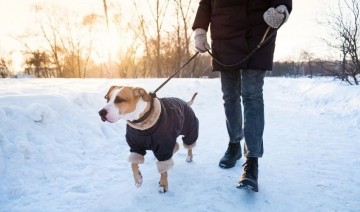
Winter Walking Tips With Your Dog
Walks are great exercise and mental stimulation for your dog, and even on the coldest days, a walk can be a welcome activity. By knowing how to safely walk your dog in winter, both you and your canine companion can enjoy fresh air, exercise, and fun on regular walks.
The Risks of Cold Weather Walks
Winter walks have unique risks and it is important to be aware of the hazards you and your dog may face when walking on colder days. Lower temperatures mean a higher risk of frostbite and hypothermia, particularly for smaller dog breeds or both puppies and senior dogs that are more vulnerable. Icy surfaces increase the risk of falls and injuries, and snowfall can remove both visual and scent markers that can make it easier to get lost if you and your dog are accidentally separated. De-icing chemicals on streets and sidewalks can be toxic and may aggravate even small cuts or sores on your dog’s feet.
Fortunately, despite the added risks of winter walks, it is easy to avoid these hazards and still enjoy regular walks with your dog.
Winter Walking Tips for You and Your Dog
No matter how long a walk you take or where you and your dog stroll through the snow, it is important to be safe at all times. To enjoy winter walks in a safe and comfortable way…
- Dress for the Weather – Consider a sweater or coat for small dogs or breeds with short coats, and boots or booties can help dogs have proper traction on icy surfaces. Be sure to layer your own clothing for better comfort in low temperatures.
- Ensure Proper Leash and Collar Fit – Your dog’s collar or harness should fit snugly but not too tight, and the leash should be firmly attached. Check both the collar and leash regularly to ensure there are no frays or weak spots where the gear could break.
- Be Reflective – Choose a collar, harness, and leash with reflective strips or decorations so your dog will be more visible in low light. Similarly, your own coat and other clothes should be bright colors for better visibility on short winter days when darkness comes early.
- Stick to Safe Routes – Follow familiar walks and routes well away from hazards or unknown terrain that could potentially be dangerous. Stay off freshly salted areas to avoid contamination on your dog’s paws, and always avoid frozen water where the ice may be unstable.
- Know Your Dog’s Limits – Be aware of your dog’s overall health, and pay attention to any signs of discomfort. Very young and very old dogs are more vulnerable to cold, and certain health conditions, such as arthritis, can be exacerbated by cold.
- Shorten Walks as Needed – On very cold days, take shorter walks instead of long rambles. If necessary, take several shorter walks throughout the day instead of just one long walk to ensure neither you nor your dog gets too cold during the walk.
- Keep a Firm Hold on Your Dog – Always keep a firm hold on your dog’s leash. If conditions are very icy, consider tying the leash to your wrist or using a clip to fasten it to your waist in case you fall and might lose your grip.
- Keep Your Dog’s Toenails Short – Very cold conditions make toenails more prone to splits and cracks, especially if they continually rub on asphalt or concrete during walks. Keeping your dog’s nails shorter in winter will minimize this risk and help prevent infection in the nails.
- Provide Plenty of Water for Hydration – Even on cold days, your dog can become dehydrated while exercising. Be sure you offer plenty of fresh, clean water to keep your dog properly hydrated, and avoid letting them eat ice or snow that could chill them from the inside.
- Always Pick Up After Your Pet – Snow may hide your dog’s droppings, but when the snow melts, the droppings will still be there and accumulated droppings will become an environmental hazard. Be a courteous dog owner and always pick up after your dog’s potty business.
Above all, be alert to your dog’s condition at all times, and know when conditions may be too cold for a winter walk. Excessive shivering and reluctance to stay outdoors are sure signs that it is too cold for your dog to be outside, and it will be best to exercise with fun indoor games instead. With proper precautions, both you and your pet can enjoy winter walks and know how to keep safe and comfortable when exercising all winter long.

